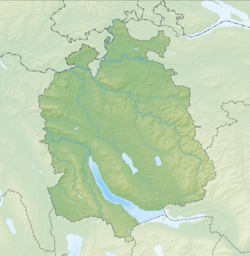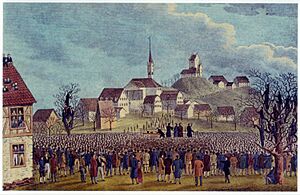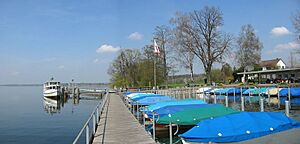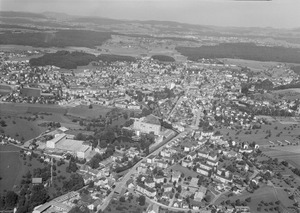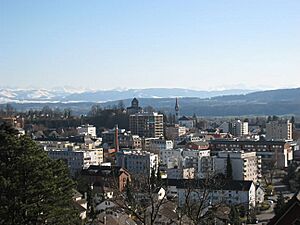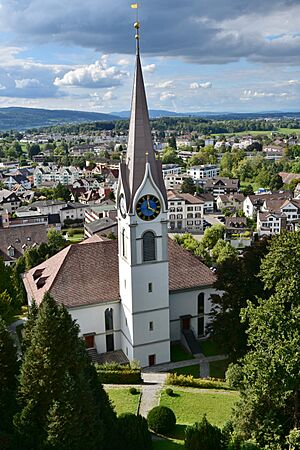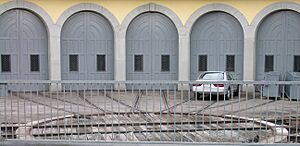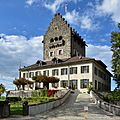Uster facts for kids
Quick facts for kids
Uster
|
||
|---|---|---|
 |
||
|
||
| Country | Switzerland | |
| Canton | Zürich | |
| District | Uster | |
| Area | ||
| • Total | 28.49 km2 (11.00 sq mi) | |
| Elevation | 462 m (1,516 ft) | |
| Population
(Dec 2020 )
|
||
| • Total | 35,337 | |
| • Density | 1,240.33/km2 (3,212.4/sq mi) | |
| Postal code |
8610
|
|
| Localities | Kirchuster, Freudwil, Nänikon, Niederuster, Nossikon, Oberuster, Riedikon, Sulzbach, Wermatswil, Werrikon, Winikon-Gschwader | |
| Surrounded by | Fehraltorf, Gossau, Greifensee, Maur, Mönchaltorf, Pfäffikon, Seegräben, Volketswil | |
| Twin towns | Prenzlau (Germany) | |
Uster is a town in Switzerland. It is the main town of the Uster District in the canton of Zürich. Uster is an important place in the Zürcher Oberland region. It is located right next to a beautiful lake called Greifensee.
Uster has grown a lot because of the Zürich S-Bahn train network. With over 36,000 people living there, it is the third largest town in the canton of Zürich. It is also one of the twenty biggest towns in all of Switzerland.
The main language spoken in Uster is a local type of Swiss German. The official language is German. In 2001, Uster won the Wakker Prize. This award recognizes towns that do a great job of keeping their unique identity and building well.
Contents
History of Uster
The village of Riedikon, which is part of Uster today, was first mentioned in history in the year 741. Uster itself was first written about in 775. Back then, it was called Ustra villa. Some experts think the name "Uster" comes from an old word meaning "hungry river."
The St. Andreas Church was first mentioned in 1099. It was a large church with three main sections. Burg Uster (Uster Castle) was first mentioned in 1267. At that time, it belonged to a noble family called the Freiherr von Bonstetten.
In 1300, a noblewoman named Elisabeth von Rapperswil sold the area around Greifensee to a knight. This included Greifensee castle, the town, the lake, and many farms. It also included the rights to the church in Uster. Later, in 1438, the church rights were sold to the Rüti Monastery.
The Old Zürich War
During the Old Zürich War in May 1444, soldiers from the Old Swiss Confederacy attacked the nearby town of Greifensee. About 70 people defended the town. After four weeks, the town was captured. Most of the defenders were sadly beheaded the next day. This was seen as a very cruel act, even during wartime.
After the monastery was closed in 1525 during the Reformation in Zürich, the city of Zürich took over the church rights. A new Reformed church was built and opened in 1824.
The Ustertag Meeting
On November 22, 1830, about 10,000 men from the canton of Zürich gathered near Uster. They demanded a new constitution for their canton. This important meeting is known as the Ustertag. It was one of several meetings in Switzerland that led to the country becoming a federal state. This means that Switzerland became a country with a strong central government, rather than just a group of independent states.
Geography and Landscape
Uster covers an area of about 28.5 square kilometers (11 square miles). A large part of this land, about 44.4%, is used for farming. Forests cover 27.1% of the area. The rest of the land, about 26.2%, has buildings or roads. A small part (2.3%) is made up of rivers, lakes, or mountains.
In 1996, buildings and houses made up 18.4% of Uster's total area. Roads and other transportation areas made up 7.8%. Water, like streams and lakes, was 0.4% of the non-productive land. As of 2007, about 22.2% of the town's area was being developed with new construction.
People and Population
Uster has a population of over 36,000 people. As of 2007, about 21.6% of the people living in Uster were from other countries. In 2008, the population was almost evenly split between males (49.6%) and females (50.4%). Over the past 10 years, Uster's population has grown by about 14.2%.
Most people in Uster (85.0%) speak German. Italian is the second most common language (4.5%), followed by Albanian (1.7%).
Education in Uster
Uster has many schools for different age groups. Primarschule Uster is for primary school children. Sekundarschulverwaltung Uster is for secondary school students.
The Bildungszentrum Uster is a large education center. It includes a vocational school, a high school called Kantonsschule Uster, and a higher technical school. The Japanese School in Zurich, which is the only Japanese international school in Switzerland, is also located in Uster.
Uster also has public libraries. The Stadt- und Regionalbibliothek Uster and the Stadtarchiv und Kläui Bibliothek are in the city center. There is also the Bibliothek Nänikon in the Nänikon area of Uster.
Work and Jobs
Uster has a low unemployment rate of 3.28%. In 2005, about 392 people worked in farming. There were 92 businesses in this area. About 3,204 people worked in manufacturing and industry, with 238 businesses. The largest number of people, 9,475, worked in the service sector, which includes things like shops, offices, and healthcare. There were 1,091 businesses in this sector.
In 2007, about 51.5% of working people had full-time jobs. The other 48.5% worked part-time.
Religion
In 2008, there were about 9,366 Catholics and 11,890 Protestants in Uster. According to the 2000 census, about 45% of the people were Protestant. Most of these belonged to the Swiss Reformed Church. About 31.7% of the population was Catholic. Other religions, like Islam, were also present. Some people did not state a religion, and about 11.7% said they were atheist or agnostic.
Weather in Uster
Uster usually has rain on about 135.4 days each year. On average, it gets about 1164 millimeters (45.8 inches) of rain per year. June is the wettest month, with about 137 millimeters (5.4 inches) of rain over 13.1 days. October is the driest month, with about 69 millimeters (2.7 inches) of rain over 13.1 days.
Wakker Prize Award
Uster won the Wakker Prize in 2001 from the Swiss Heritage Society. This award was given because Uster has done a great job of keeping its unique character. The Society noted that the developed areas of the town are clearly separate from the surrounding farmland. They also praised how Uster has mixed old and new buildings in a way that looks good together.
Notable People from Uster
Many interesting people have come from Uster. Here are a few:
- Leandra Columberg (born 1999), a Swiss politician.
- Jakob Heusser-Staub (1862–1941), a Swiss businessman and generous giver to charity.
- Hedi Lang (1931–2004), a Swiss politician who was the first woman elected to a cantonal executive position.
- Stenia Michel (born 1987), a Swiss football player who is a goalkeeper for FC Basel.
- Philippe Montandon (born 1982), a retired football player who played over 300 professional games.
- Roeland Wiesnekker (born 1967), an actor from the Netherlands and Switzerland who acts in movies and plays.
Transportation
Uster has good train connections. There are two railway stations: Uster railway station in the town center and Nänikon-Greifensee railway station near the border with Greifensee. Both stations are served by the Zürich S-Bahn train lines.
You can get from Uster to Zürich Hauptbahnhof (Zurich's main train station) in just 14 minutes on the fastest trains.
Images for kids
See also
 In Spanish: Uster para niños
In Spanish: Uster para niños




